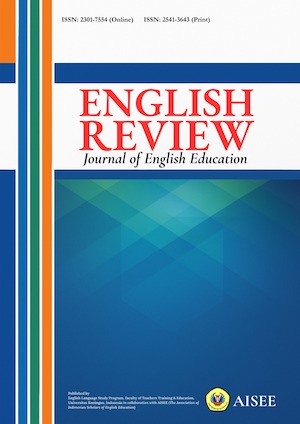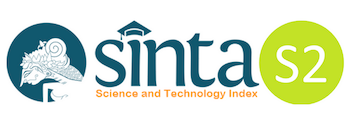DEVELOPMENT OF VIDEO-BASED DIGITAL CONTENT LEARNING FOR TEACHING UNIVERSITY STUDENTS
Abstract
Nowadays, technological developments are really very fast so it requires students to be able to follow them. Like what was done during a pandemic, learning was done online so lecturers had to prepare the material properly by using internet facilities for teaching. Unfortunately, learning is still considered to have many problems during the pandemic, both in terms of material and media used, resulting in a learning loss. This study highlights the development of video-based digital content learning which are integrated into learning. The method used in this study was research and development. The steps to develop the media were applied Four-D model by Thiagarajan and Semmel. The video-based digital content learning presents interactive learning in the form of videos integrated with learning management system, ELITA. The media has been tested on 25 students at Universitas Tidar during the covid-19 pandemic and showed good acceptance. The results of this study indicate that video-based digital content is feasible and effective to be used in supporting student motivation and learning outcomes. This implies that digital content learning is of value to be used and applied in online learning for teaching university students.References
Aini, Z., Muslem, A., & Marhaban, S. (2021). Investigating students’ motivation and problems toward the use of zoom platform in English teaching and learning process during the covid-19 pandemic. English Education Journal, 12(4), 613–630. https://doi.org/10.24815/eej.v12i4.21213
Anggraeni, A. A., Sumaryana, Rinawati, W., & Murniati, D. E. (2021). The development of video on pickled fruit production for flipped classroom. International Journal of Interactive Mobile Technologies, 15(9), 118–135. https://doi.org/10.3991/ijim.v15i19.22695
Arochman, T., & Fortinasari, P. B. (2024). Implementation of Technology-Based Learning by Pre-Service Teachers During Teaching Practice Program. Premise: Journal of English Education and Applied Linguistics, 13(1), 126–146. https://doi.org/10.24127/pj.v13i1.8988
Arochman, T., Malasari, S., & Yunianti, S. S. (2023). The Effect of ELITA on English Writing Learning for College Students. VELES: Voices of English Language Education Society, 7(1), 75–85. https://doi.org/10.29408/veles.v7i1.7524
Asri, A. N., Mubarok, F. U., & Imron, A. (2022). The Implementation of Low-Cost Educational Videos to Improve Students’ Performance in TOEIC Preparation Test. English Review: Journal of English Education, 10(2), 499–508. https://doi.org/10.25134/erjee.v10i2.6250
Coleman, T. E., & Money, A. G. (2020). Student-centred digital game–based learning: A conceptual framework and survey of the state of the art. Higher Education, 79, pages415–457. https://doi.org/10.1007/s10734-019-00417-0
Delimasari, A., Fauziah, N., Anjarsari, D. P., & Arochman, T. (2023). Classroom’s Environment and FOMO: Students’ Perspectives. IDEAS: Journal on English Language Teaching and Learning, Linguistics and Literature, 11(2), 1494–1506. https://doi.org/10.24256/ideas.v11i2.3941
Deng, R., & Gao, Y. (2023). A review of eye tracking research on video-based learning. Education and Information Technologies, 28, 7671–7702. https://doi.org/10.1007/s10639-022-11486-7
Divayuda, I. P. G. B. T., Wibawa, I. M. C., & Rati, N. W. (2021). Prezi-based learning video: Learning media validity and feasibility. International Journal of Elementary Education, 5(3), 505–514. https://doi.org/10.23887/ijee.v5i3.37058
Haleem, A., Javaid, M., Qadri, M. A., & Suman, R. (2022). Understanding the role of digital technologies in education: A review. Sustainable Operations and Computers, 3, 275–285. https://doi.org/10.1016/j.susoc.2022.05.004
Händel, M., Stephan, M., Gläser-Zikuda, M., Kopp, B., Bedenlier, S., & Ziegler, A. (2020). Digital readiness and its effects on higher education students’ socio-emotional perceptions in the context of the covid-19 pandemic. Journal of Research on Technology in Education, 54(2), 267–280. https://doi.org/10.1080/15391523.2020.1846147
Hartman, R. J., Townsend, M. B., & Jackson, M. (2019). Educators’ perceptions of technology integration into the classroom: A descriptive case study. Journal of Research in Innovative Teaching & Learning, 12(3), 236–249. https://doi.org/10.1108/jrit-03-2019-0044
Ilyas, M., Syarif, H., & Refnaldi. (2023). The Use of English Language Learning Videos Designed Through Canva App: Students’ Perceptions. International Journal of Interactive Mobile Technologies, 17(8), 100–112. https://doi.org/10.3991/ijim.v17i08.39215
Lacey, K., & Wall, J. G. (2021). Video-based learning to enhance teaching of practical microbiology. FEMS Microbiology Letters, 368(2). https://doi.org/10.1093/femsle/fnaa203
Lestari, D. E. (2020). Rethinking the roles of English lecturers in the digital era. Metathesis: Journal of English Language, Literature, and Teaching, 4(2), 137–150. https://doi.org/10.31002/metathesis.v4i2.2508
Manurung, E. M., Purwadi, Y. S., & Sugiharto, I. B. (2022). Digital learning process: Challenges for specific creativity. Electronic Journal of E-Learning, 20(2), 112–119. https://doi.org/10.34190/ejel.20.2.2107
Marpaung, D. N., & Azzajjad, M. F. (2020). The effectiveness of student centre learning in experiment method on acid and base solution to increase student achievement. Journal of Applied Science, Engineering, Technology, and Education, 2(1). https://doi.org/10.35877/454ri.asci2156
Mijatoví, I., Toší, B., & Jovanoví, M. (2019). The acquiring of the knowledge about standards in the digital era. Amfiteatru Economic, 21(51), 427–441. https://doi.org/10.24818/EA/2019/51/427
Mustapha, I., Van, N. T., Shahverdi, M., Qureshi, M. I., & Khan, N. (2021). Effectiveness of digital technology in education during covid-19 pandemic. A bibliometric analysis. International Journal of Interactive Mobile Technologies, 15(8), 136–154. https://doi.org/10.3991/ijim.v15i08.20415
Novaliendry, D., Saltriadi, K. S., Mahyuddin, N., Sriwahyuni, T., & Ardi, N. (2022). Development of interactive media based on augmented reality for early childhood learning around the home. International Journal of Interactive Mobile Technologies, 16(24), 4–20. https://doi.org/https://doi.org/10.3991/ijim.v16i24.34501
Othman, H. S., Zaibon, S. B., & Abidin, A. H. Z. (2022). The significance of Edutainment concept in video-based learning in proposing the elements of educational music video for children’s learning. International Journal of Interactive Mobile Technologies, 16(5), 91–106. https://doi.org/10.3991/ijim.v16i05.23711
Pamungkas, W. A. D., & Koeswanti, H. D. (2021). Penggunaan media pembelajaran video terhadap hasil belajar siswa sekolah dasar. Jurnal Ilmiah Pendidikan Profesi Guru, 4(3), 346–354. https://doi.org/10.23887/jippg.v4i3.41223
Pardede, Y. K., Yuhana, Y., & Pamungkas, A. S. (2021). Pengembangan Video Pembelajaran Berbasis Numerasi untuk Siswa Sekolah Dasar. Primary: Jurnal Pendidikan Guru Sekolah Dasar, 10(6), 1664 – 1671. https://doi.org/10.33578/jpfkip.v10i6.8353
Puspitarini, Y. D., Akhyar, M., & . D. (2019). Development of video media based on powtoon in social sciences. International Journal of Educational Research Review, 4(2), 198–205. https://doi.org/10.24331/ijere.518054
Ramadani, A., & Xhaferi, B. (2020). Teachers’ experiences with online teaching using the zoom platform with EFL teachers in high schools in Kumanova. SEEU Review, 15(1), 142–155. https://doi.org/10.2478/seeur-2020-0009
Riyanto, E. D. (2020). The benefits of integrating video making in a speaking class. English Language Teaching Educational Journal, 3(1), 64–74. https://doi.org/10.12928/eltej.v3i1.1850
Ryan, T. (2021). Designing video feedback to support the socioemotional aspects of online learning. Educational Technology Research and Development, 69, 137–140. https://doi.org/10.1007/s11423-020-09918-7
Sablić, M., Mirosavljević, A., & Škugor, A. (2021). Video-based learning (VBL)—past, present and future: An overview of the research published from 2008 to 2019. Technology, Knowledge and Learning, 26, 1061–1077. https://doi.org/10.1007/s10758-020-09455-5
Sari, A. B. P., Dardjito, H., & Azizah, D. M. (2020). EFL students’ improvement through the reflective youtube video project. International Journal of Instruction, 13(4), 393–408. https://doi.org/10.29333/iji.2020.13425a
Sariyatun, Suryani, N., Sutimin, L. A., Abidin, N. F., & Akmal, A. (2021). The effect of digital learning material on students’ social skills in social studies learning. International Journal of Instruction, 14(3), 417–432. https://doi.org/10.29333/iji.2021.14324a
Tan, S., Zou, L., & Wijaya, T. T. (2020). Using video learning to improve students’ mathematical ability. Journal of Didactic Mathematics, 1(3), 117–126. https://doi.org/10.34007/jdm.v1i3.364
Thiagarajan, S. (1974). Instructional development for training teachers of exceptional children. In A sourcebook.
Varghese, A., Shama, B., Anil, D. V., Bhosale, B. P., Shivdas, K., Upendra, S., & Mistry, M. (2020). A study to assess the effectiveness of video assisted teaching (VAT) on knowledge of environmental hygiene in rural community. Indian Journal of Forensic Medicine and Toxicology, 14(4), 3993–3996. https://doi.org/10.37506/ijfmt.v14i4.12265
Voithofer, R., & Nelson, M. J. (2021). Teacher educator technology integration preparation practices around TPACK in the United States. Journal of Teacher Education, 72(3), 314–328. https://doi.org/10.1177/0022487120949842
Wahyuningsih, L., Huwaidah, H. K., Maryam, F. F. D., & Arochman, T. (2023). Learners strategies used by non-English department students in learning English: Students’ perspective. KABASTRA: Kajian Bahasa Dan Sastra, 3(1), 12–22. https://doi.org/10.31002/kabastra.v3i1.1083
Wicaksono, H. A., & Pristiwati, R. (2021). The suitability of video learning media on youtube with poetry writing learning materials curriculum. International Journal of Active Learning, 6(1), 9–16.
All articles published in English Review: Journal of English Education (ERJEE) are licensed under the Creative Commons Attribution 4.0 International License (CC BY 4.0).
Copyright Ownership
Authors retain the copyright of their articles and grant ERJEE the right of first publication. The journal is granted a non-exclusive license to publish, reproduce, and distribute the article in any format, medium, or platform, provided that proper credit is given to the original authors.
License Terms – CC BY 4.0
Under the Creative Commons Attribution 4.0 International License, others are free to:
- Share — copy and redistribute the material in any medium or format
- Adapt — remix, transform, and build upon the material for any purpose, even commercially
As long as they:
- Provide appropriate credit to the original author(s) and source
- Provide a link to the license (https://creativecommons.org/licenses/by/4.0/)
- Indicate if any changes were made
There are no restrictions on the reuse, reproduction, or adaptation of published articles as long as attribution is properly given.
Author Warranties
By submitting a manuscript to ERJEE, authors confirm that:
- The work is original and does not infringe any existing copyright.
- The manuscript has not been previously published and is not under consideration elsewhere.
- All sources and references are appropriately acknowledged.
- Necessary permissions have been obtained for any copyrighted materials used.









